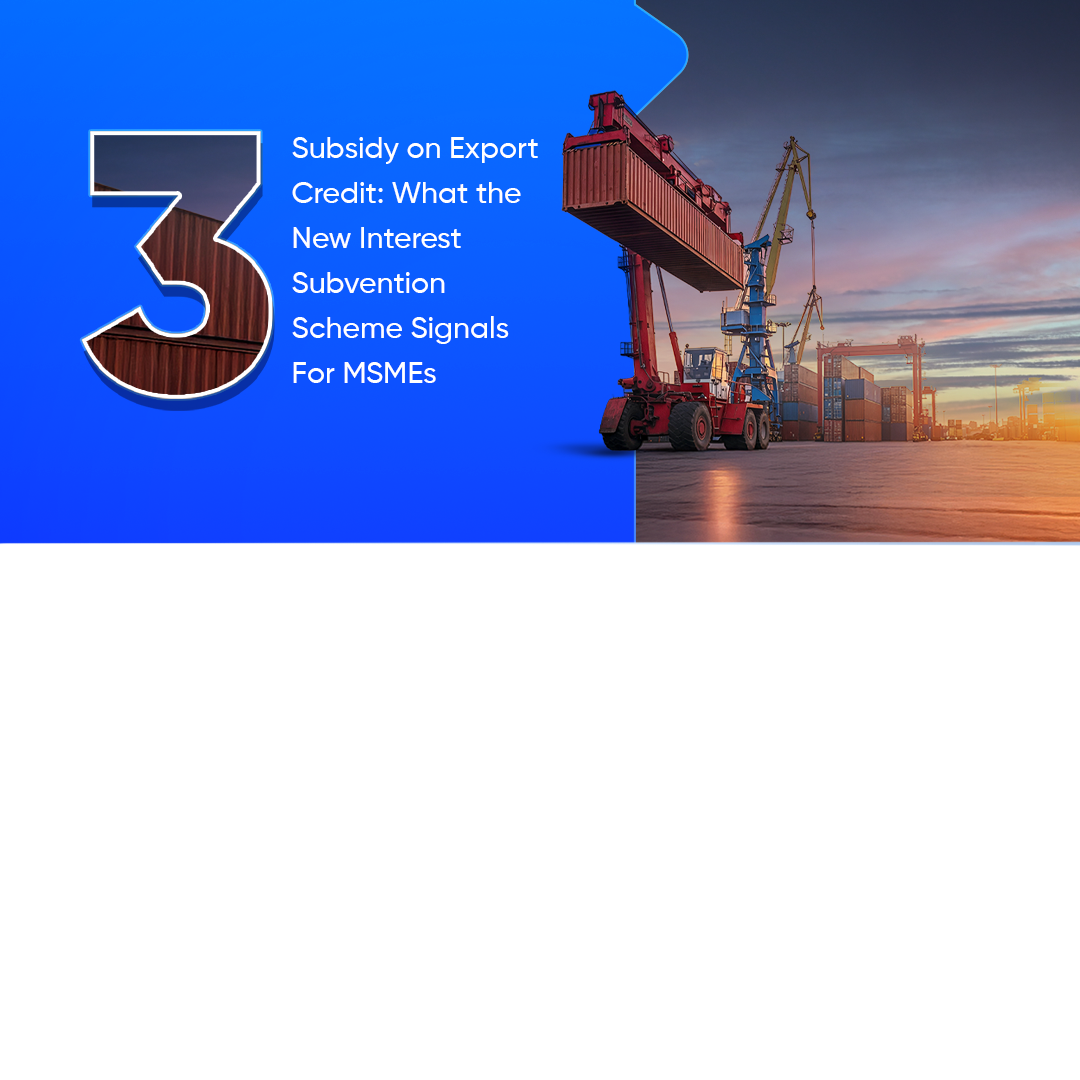3% Subsidy on Export Credit: What the New Interest Subvention Scheme Signals for MSMEs
- The government is set to introduce a new interest subvention scheme offering a 3% subsidy on export-linked credit for MSMEs, which will be valid for five years, giving exporters greater clarity for long-term planning.
- The scheme aims to support labor-intensive export sectors impacted by global uncertainties and rising operational costs.
- The subsidy is expected to ease credit costs for MSME exporters by improving liquidity, strengthening financial stability, supporting steady production, and enabling more competitive pricing in global markets.
The Government of India is preparing to introduce a revamped Interest Subvention Scheme that will offer a 3% interest subsidy for MSME exporters over the next five years. The initiative is designed to ease borrowing costs, improve liquidity, and support competitiveness at a time when exporters are dealing with unpredictable global conditions, including geopolitical tensions, Red Sea shipping disruptions, volatile freight costs, and tariff-related challenges in key markets.
This blog article looks at what the scheme entails and what it means for MSME exporters.
What is Interest Subvention and what the New Scheme will Offer
Interest subvention refers to a government-funded reduction in the interest rate on pre-shipment and post-shipment credit, effectively lowering the cost of borrowing by absorbing a portion of the interest payable by the exporter. This framework is expected to function similarly to the earlier Interest Equalisation Scheme (IES), which expired in 2024. Familiar processes will allow MSMEs to access benefits without navigating new administrative steps.
IES brought effective borrowing rates down from roughly 9–12% to about 5–7%, reducing financial pressure on exporters. In FY24, the scheme amounted to ₹3,699 crore for the exchequer, while expenditure eased to approximately ₹2,482 crore in FY25 owing to its partial rollout. The upcoming version is expected to be incorporated into the Export Promotion Mission (EPM) for FY2026, which is currently undergoing inter-ministerial review.
The new scheme is expected to offer a 3% interest subsidy on export-linked credit for MSMEs and remain valid for five years, giving small exporters greater stability for long-term planning. It will primarily support labor-intensive sectors that generate significant employment and is likely to be implemented through commercial banks and NBFCs under the Reserve Bank of India’s existing interest equalization framework.
Why MSME Exporters Need This Support Now
Export-oriented MSMEs operate on thin margins and rely heavily on uninterrupted working capital. When credit becomes expensive, even well-managed enterprises struggle to maintain production cycles, procure raw materials on time, or accept new orders. Although MSMEs contribute nearly 45% of India’s total exports, many continue to face high financing costs that reduce their ability to price competitively.
Sectors such as textiles, garments, gems and jewellery, handicrafts, leather, footwear, and toys depend on consistent demand from international buyers. Fluctuating procurement cycles and increased operational expenses make it difficult for smaller units to manage cash flows. A targeted interest subsidy directly addresses this gap by easing the cost of credit and providing stability during uncertain export cycles.
The government’s decision to reintroduce interest relief for exporters signals long-term support for MSME-led trade growth through:
- Lower Borrowing Costs
A 3% reduction directly frees up capital. MSMEs can redirect these savings toward raw materials, additional labor, packaging, or essential machinery upkeep, which ensures steady production.
- Improved Liquidity
Export cycles often involve delayed payments from overseas buyers. More affordable credit helps MSMEs bridge cash-flow gaps without compromising output.
- Better Pricing Power
Competitive pricing is essential for retaining international buyers. Lower interest costs reduce overall production expenditure, helping MSMEs offer more attractive quotations.
- Greater Financial Stability
Unexpected fluctuations in demand or delivery timelines can strain finances. Access to cheaper credit strengthens resilience, enabling exporters to withstand temporary setbacks without disrupting operations.
Small units, in particular, benefit significantly from even modest reductions in interest rates. Savings accumulated over a year can support business expansion, workforce hiring, or investment in better tooling.
Broader Economic Significance
The interest subvention scheme supports India’s vision of expanding export capacity and strengthening smaller manufacturing ecosystems. It aligns closely with the objectives of the Foreign Trade Policy 2023, which focuses on deeper global integration of local enterprises, and supports India’s ambition to reach $2 trillion in exports by 2030, a target that depends heavily on sustained participation from MSMEs. Consistent policy support helps reduce operational barriers and creates an ecosystem where exporters can focus on quality, delivery, and innovation.
The scheme also complements broader initiatives such as:
Remission of Duties and Taxes on Exported Products (RoDTEP): Provides refunds on hidden taxes, helping exporters remain competitive.
Export Promotion Capital Goods (EPCG) Scheme: Enables exporters to upgrade to advanced machinery at concessional rates.
Production Linked Incentive (PLI) Schemes: Promote scale, efficiency, and technological advancement across manufacturing sectors.
Together, these programs address cost, compliance, and credit challenges, creating a more stable foundation for MSME export growth.
To avail of the scheme, MSMEs must ensure that their export operations and documentation are fully compliant with existing regulations. This includes holding a valid Udyam Registration, maintaining an active Importer Exporter Code (IEC), and securing loans that are formally classified as export credit by their lending institution. Accurate export records, timely filings, and consistent repayment behavior will also play an important role in ensuring smooth verification and access to the interest subsidy once the scheme is implemented.
The introduction of a new interest subvention scheme comes at a critical moment for MSME exporters striving to remain competitive in a fluctuating global landscape. By reducing borrowing costs and improving liquidity, the initiative enhances financial stability and supports uninterrupted production cycles. Its long-term structure signals continued policy commitment to nurturing India’s export-driven sectors.
Source: Ministry of Commerce and Industry, March 2025

